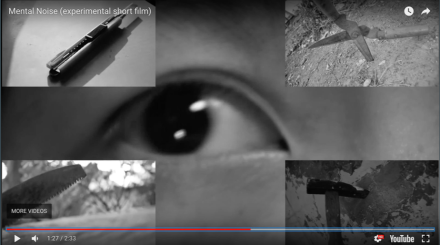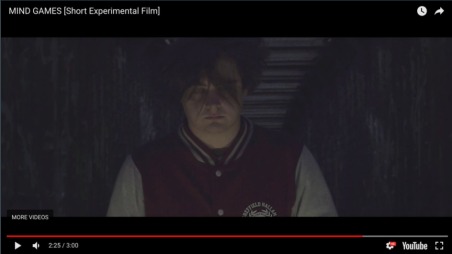Group 6:
Chan Wing Man 54592817
Chung Yik Ching 54414080
PORPOSING STAGE:
Do you think these masterpieces are stunning?
In fact, the artists were suffering with psychological disorders during their lifes. Namely, Vincent Van Gogh had depression, hallucination, mania and etc.; Edvard Munch had depression, hallucination, bipolar disorder and etc.; Francisco Goya had depression; Beethoven had bipolar disorder, seasonal affective disorder, comorbid bipolar disorder and etc.
They all had been through traumatic events in their lifetime, such as tragic deaths and chronic health issues. For example:
- Vincent Van Gogh was rejected in his whole life time, including friendships, art works and love. When he was young, he volunteered to be a pastor to preach but was rejected by the church. His painting also got rejected and negatively criticised by other painters. He tried to meet new friends but he hardly got one because of his unstable mind. His only friend was his younger brother Theo.
- Edvard Munch’s mother died when he was only five and he witnessed his sister’s death when he was a teenager. His other siblings got mental illness or died when he grew older. He injured his thumb with a gun because of an unpleasant relationship with a woman he pursue relentlessly. With the tragic childhood and other difficult times, he started to get mental problems, especially depression, which got worse and worse.
Their sufferings led to their distinctive art styles:
- Van Gogh used innovative color which brought bright paintings (e.g. vibrant and intense, dominant bright yellow). He paints very thick layers so that we can feel the texture by looking. He loves to use swirl shapes to describe his feelings and what he sees from the distorted world, his brush movement is trembling which shows his inner heart.
- Edvard Munch used darker tones in his paintings to express his condition, which is very different from his early works. He painted The Scream after he experienced an anxiety attack from an evening walk where the sun turned blood red. He used expressive images to show to a psychotic experience of visual hallucination. The rounded shapes and brushwork he used can easily grab viewers’ attention and articulate the emotions.
So…what is psychological disorders?
According to the definition in DSM-5, “A mental disorder is a syndrome characterized by clinically significant disturbance in an individual’s cognition, emotion regulation, or behavior that reflects a dysfunction in the psychological, biological, or developmental processes underlying mental functioning.”
The complete listing of DSM-5 chapters is:
- Neurodevelopmental Disorders
- Schizophrenia Spectrum and Other Psychotic Disorders • Bipolar and Related Disorders
- Depressive Disorders
- Anxiety Disorders
- Obsessive-Compulsive and Related Disorders
- Trauma- and Stressor-Related Disorders
- Dissocia ve Disorders
- Somatic Symptom Disorders
- Feeding and Eating Disorders
- Elimina on Disorders
- Sleep-Wake Disorders
- Sexual Dysfunctions
- Gender Dysphoria
- Disruptive, Impulse Control and Conduct Disorders
- Substance Use and Addictive Disorders
- Neurocognitive Disorders
- Personality Disorders
- Paraphilic Disorders
- Other Disorders
We have found connections between psychological disorders and creativity.
“According to Hershman and Lieb, bipolar disorder can contribute to creativity (11). … This, they say, is because depression can make one a perfectionist, while mania evokes more ambition, indefatigability, and faith in oneself (11). …Indeed, Dr. Robert A. Pentky, a psychologist from the Boston University Medical School, has concluded that “the cognitive flexibility necessary to realize extraordinary conceptual insights and theoretical breakthroughs is characteristic, in a less severe form, of psychotic thought process” (qtd. in Mai 185). ”
Here is our project concept:
- To study the backgrounds and to understand the impacts of the psychological disorders on famous artists
- To study how they express themselves artistically
- To put ourselves into their state of mind
- To create an artwork based on our interpretations and subjective emotions
The psychological theories we would adopt is role reversal by Zerka Moreno in psychodrama. According to Michigan Psychodrama Center, role reversal means taking or “playing” the role of another. In psychodrama when you “role reverse” you attempt to “become” another person. This can happen in many different ways depending on the needs of the individual and the needs of the group.
Besides, according to Freud (Sigmund Freud), “the conscious and unconscious parts of the mind can come into conflict with one another, producing a phenomena called repression (a state where you are unaware of having certain troubling motives, wishes or desires but they influence you negatively just the same). In general, psychodynamic theories suggest that a person must successfully resolve early developmental conflicts (e.g., gaining trust, affection, successful interpersonal relationships, mastering body functions, etc.). in order to overcome repression and achieve mental health. Mental illness, on the other hand, is a failure to resolve these conflicts.”
Implementaion plan
After stating our field of interest, we intend to put ourselves into the mental states of the artists and then imagine and visualize what their inner worlds are as in the modern society. We will create an experimental short film (non-narrative) (<4mins) as our final artwork.
Below are some existing creative videos for reference:



Project Development Process
Storyboard:
Behind the scenes:




Interview with Doctoral student in Clinical Psychology, Billy Chan
In order to gain a deeper understanding and inspirations towards the topic, we did a Skype interview with an Clinical Psychology expert. For the whole interview, please view: https://drive.google.com/file/d/1TtxLBO6T3xpbJqVqjfEHpvEmTFOuu0Z7/view?usp=sharing
In fact, what Billy mentioned was closely related to our topic. In 7:22, he said, “…for a lot of artists, a lot of people who are musicians, engineers…when they start to produce a lot of work, if we know they have a history of mood disorder, this will be a reference for us, clinicians, to be mindful of where they’re standing, their functions. Because they’re too busy… not sleeping not eating not showering, and this will reduce their quality of life…”
Further quotes from the artist:
“I put my heart and my soul into my work, and lost my mind in the process,” Van Gogh once said.
Munch wrote in his diary, “My fear of life is necessary to me, as is my illness. They are indistinguishable from me, and their destruction would destroy my art.”
Our Final artwork:
Elaboration on the artwork
- We picked 4:3 aspect ratio so as to create a more compressed point of view as compared to the common 16:9.
- The video contains three chapters: depression, hallucination followed by bipolar.
- The first chapter depicts a dark and suppressed mental state which the character is trapped inside her mind. She is also being burnt alive to create a sense of hopelessness.
- The second chapter crosses cut between the reality and the head. The reality part is filtered by Van Gough painting style and inside the head is a montage of a killing scene. The former implies that what is real may not be realistic when a person has hallucination and the later might be even more realistic. Towards the end of this chapter, there is a POV of the person walking in the same street without distortion (like the beginning) this time, signalling the hallucination fades away.
- The last chapter is about bipolar. First, it is the patient lying in bed as she losses interest in daily activities. The image contracts gradually while eight other grids emerge. This implicates the patient’s manic state takes over the depressive state. She does multiple tasks for days and nights without sleep, showing aggression and anger. The background music is first accompanied by Beethoven’s Moonlight 1st movement that is calming and blue. However, Moonlight 3rd movement cut in when the patient enters manic episode. It is faster, more energetic and intense.
Reflections
As the video is rather conceptual without a clear storyline behind, we find it challenging to build a strong connection between visuals and sound. It requires a large amount of post-production work as we need skilful editing. For example, we did green screen, split screens and overlay filters. It is our first time to DIY a green screen and it worked well surprisingly. Besides, sound mixing part is also important as it helps establishes the atmosphere of the “inner world”. We built several layers of audio track in the video to make things more realistic. For example, the ambience air sound would make the depression part more empty, detached and lonely while a high pitch sound would make the hallucination part more disturbing.
Reference list:
Dehm, P. (2017). Http://ljournal.ru/wp-content/uploads/2017/03/a-2017-023.pdf. Beethoven: The Man and the Madness behind the Music. doi:10.18411/a-2017-023
Introduction to Psychodrama (pp. 3-6, Publication). (2010). Cambridge. doi:https://www.iasa-dmm.org/images/uploads/Chip Chimera and Clark Baim Workshop on Psychodrama.pdf
Ferreira, B. (2018, April 04). 4 Artists Who Suffered Mental Illness (And How It Affected Their Art). Retrieved from http://www.dailyartmagazine.com/artists-who-suffered-mental-illness/
Rustin, T. A. (2008, July 8). Using artwork to understand the experience of mental illness: Mainstream artists and Outsider artists. Retrieved from https://www.ncbi.nlm.nih.gov/pmc/articles/PMC2736519/
NEMADE, R., REISS, N. S., & DOMBECK, M. (n.d.). Psychology Of Depression- Psychodynamic Theories. Retrieved from https://www.mentalhelp.net/articles/psychology-of-depression-psychodynamic-theories/
Barone, P. (2015, November 15). What is Role Reversal? Retrieved from http://www.michiganpsychodramacenter.com/what-is-role-reversal/#_edn1
Creativity and mental illness. (2018, November 08). Retrieved from https://en.m.wikipedia.org/wiki/Creativity_and_mental_illness
Jayatunge, R. M. (n.d.). Psychological Reflections of Vincent Van Gogh’s Art. Retrieved from http://www.dailynews.lk/2015/09/22/features/psychological-reflections-vincent-van-gogh’s-art
Sherman, D. (2005, October 13). Edvard Munch – Fear, Illness and Fame. Retrieved from https://www.sleepandhealth.com/edvard-munch-fear-illness-and-fame/
Rothernberg, A. (n.d.). Creativity and Mental Illness II: The Scream. Retrieved from https://www.psychologytoday.com/us/blog/creative-explorations/201503/creativity-and-mental-illness-ii-the-scream
Jayatunge, R. M. (2015, September 22). Psychological Reflections of Vincent Van Gogh’s Art. Retrieved from http://www.dailynews.lk/2015/09/22/features/psychological-reflections-vincent-van-gogh’s-art
Sample, I. (2015, June 08). New study claims to find genetic link between creativity and mental illness. Retrieved from https://www.theguardian.com/science/2015/jun/08/new-study-claims-to-find-genetic-link-between-creativity-and-mental-illness